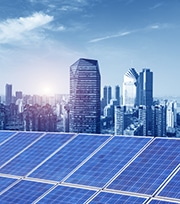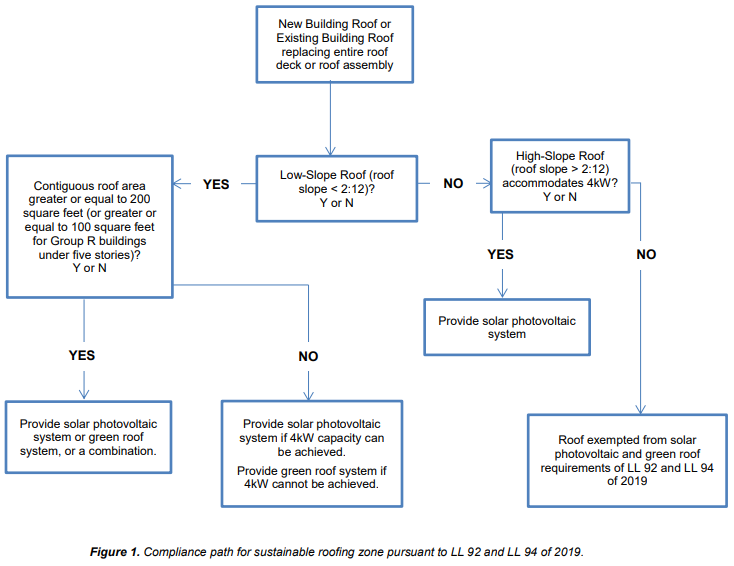- November 04, 2019
- 0 Comments
- In Existing Building Performance
- By Steven Winter Associates
 As part of the Climate Mobilization Act, and in accordance with the its greater carbon emissions reduction goals, New York City passed Local Laws 92 and 94 in April 2019, mandating the installation of rooftop solar photovoltaic systems and/or green roofs on buildings across the city. The new requirements will go into effect on November 15, 2019 and will apply to all new buildings and any existing buildings completing a full roof deck or assembly replacement.
As part of the Climate Mobilization Act, and in accordance with the its greater carbon emissions reduction goals, New York City passed Local Laws 92 and 94 in April 2019, mandating the installation of rooftop solar photovoltaic systems and/or green roofs on buildings across the city. The new requirements will go into effect on November 15, 2019 and will apply to all new buildings and any existing buildings completing a full roof deck or assembly replacement.
The Mayor’s Office estimates that the solar and green roof installations mandated by these bills will result in 300 MW of new solar capacity, 15 million gallons of new stormwater management capacity, 1 million tons of greenhouse gas reductions, and hundreds of green jobs. Based on these projections, this will account for close to 2.5% of the city’s overall emissions reduction goals.*
The laws require that solar and/or a green roof be installed on all available roof space. Areas deemed “not available” and excluded from the requirements include:
- Areas obstructed by rooftop structures, mechanical equipment, towers, parapets, guardrails, solar thermal systems, cisterns, etc.;
- Fire access pathways and zoning setbacks;
- Recreational spaces that are recorded in the Certificate of Occupancy.
Once these exemptions are considered, the following decision tree should be used to determine a compliance pathway:
Solar is not required to be installed in shaded areas, but the minimum green roof requirements still apply. Likewise, green roofs are not required on roofs pitched greater than 2:12, but the minimum solar requirements still apply. There is also an exemption for “unfavorable site conditions” that is intended to cover other barriers that may arise. A prime example of this would be insufficient structural capacity of an existing building to support the additional weight of a solar PV system or green roof.
Lastly, there is an alternative compliance option for affordable housing. Certain affordable housing buildings will not be required to comply with the requirements until 2024 since they are often required to comply with Enterprise Green Communities, which may have a solar component. Affordable buildings allowed to choose this alternative compliance include:
- Buildings receiving city or state subsidies (HPD/DHCR loans, HDFCs, 420-c tax incentives);
- Buildings in HPD’s AEP program;
- Buildings under HPD jurisdiction.
Documentation demonstrating compliance or exemption will need to be provided to DOB for approval. Calculations of solar capacity+ and shading analysis must be completed by a NYS registered design professional or someone with one of the following credentials:
- NABCEP Certification;
- IBEW-NECA Electrical Journeyman & Apprentice Training;
- UL Credential.
While this new requirement may seem to be sudden and onerous, the installation of PV systems and green roofs carry many benefits. And, their installations are fairly straight forward. In particular, the installation of a solar PV system can be an excellent financial decision for building owners looking to save money on their electrical bills. Buildings with a large enough capacity may also have the option of hosting a community solar system, providing the building owner with an additional revenue stream. Installing PV on rooftops across the city will not only help achieve the broader emission reduction goals but will also allow for the monetization of a significant amount of unused space.
Specific language of the local laws and the DOB bulletin can be read here:
LL 92 – https://www1.nyc.gov/assets/buildings/local_laws/ll92of2019.pdf
LL 94 – https://www1.nyc.gov/assets/buildings/local_laws/ll94of2019.pdf
DOB Bulletin – https://www1.nyc.gov/assets/buildings/bldgs_bulletins/bb_2019-010.pdf
* Based on 2014 emissions levels of 52.9 million tons carbon dioxide equivalent (MtCO2e) and a 2050 target of 11.8 MtCO2e.
+ Calculations must assume a minimum panel efficiency of 15%.
Written by Eric Wallace, Senior Building Systems Engineer


